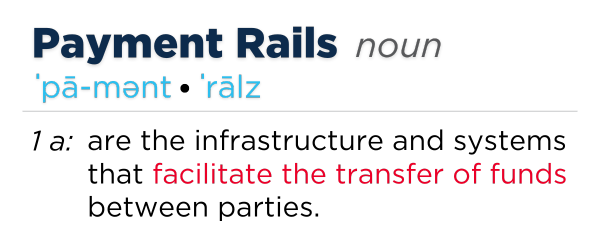All aboard the payment rail express, the ride where your financial institution’s digital payments strategy determines your loss mitigation and your users’ satisfaction.
Let’s take a closer look at a crucial pillar of digital wallets: Payment Rails

Each day we operate more and more in digital currency. Financial institutions’ payment rails fuel the movement of digital currency - and either provide a safety net against or open door for fraud and losses. Payment rails have expanded over recent years to include:
- ACH
- RTP (real-time payments)
- Card payments (POS and CNP)
- Person-to-person apps (Venmo, CashApp etc.)
- Digital wallets
- Blockchain
While accountholders might not understand the behind-the-scenes of how their money moves, financial institutions need to stay current on payment trends and adapt to how consumers want to move their money.
Do you have a digital payments strategy?
Here are four trends that can’t be ignored when it comes to building or refining your payment strategy.
1. Payments are a big deal.
Maybe it’s a no-brainer but payments are a big deal. The global payments market is valued at $240 trillion, and fintechs hold most of the market.1 Financial institutions that offer digital banking are fighting for their seat at the proverbial payments table. Payments offer a significant source of deposits for financial institutions and are worth the effort to stay on trend. Digital money is only good if it can be used and moved.
Put it into action: Focus more on the needs of the demographic you serve and less on what fintechs are doing. Stay relevant to YOUR people.
2. It’s time to give up the passwords.
Your accountholders might not care about payment rails - but they do care about the security of their money. The bad guys will often fraudulently intercept the movement of funds, knowing that these losses are untraceable. Countless scams involve password misuse. Now is the time for layers of authentication stronger than standalone passwords.
Put it into action: Deploy password use and employ biometric authentication, like voice identification, fingerprints, and facial recognition whenever possible.
3. Hello Gen Z and Welcome Gen Alpha.
Move over Millennials, two new generations are on the economic scene: Generation Z (born 1997-2010) and Generation Alpha (born 2011-present). Gen Z’s economic power is growing, and they aren’t loyalists like their Baby Boomer and Gen X predecessors. They have no qualms about taking their banking elsewhere if their payment needs aren’t being met. With the oldest members of generation Alpha not far behind Gen Z, the oldest members of this demographic cohort are now in middle school and stepping onto the payment scene.
Older generations are still large and important demographics, but Gen Z is putting demands like convenience, high security, less or no fees, and seamless integrations on the banking industry. Their digital forward style is shaping the future of payments and financial institutions must start (or continue) to tailor payment channels to Gen Z.
Put it into action: Create a multi-generational approach to digital payments. Don’t ignore Millennials, Gen X, and Boomers to stay relevant nor neglect younger generations for the sake of cutting corners.
4. Multi-rail payments are the future of digital payments.
Financial institutions, especially credit unions, must be prepared to adapt to how accountholders want to move their funds. A multi-rail strategy allows for omnichannel, real-time digital cash movement, between friends and family, and vendors – both domestically and internationally.
A strategic payment infrastructure lays the groundwork for safe and seamless payments.
Put it into action: Integrate an easily navigable digital payments platform with 24/7 transaction monitoring system into your core processor.
The market demands fast, secure, multi-rail payments. Are you prepared?
1 https://www.linkedin.com/pulse/fintech-food-future-payments-simon-taylor-/?utm_source=AlliedSolutions&utm_medium=hyperlink&utm_campaign=AlliedInsights230413
